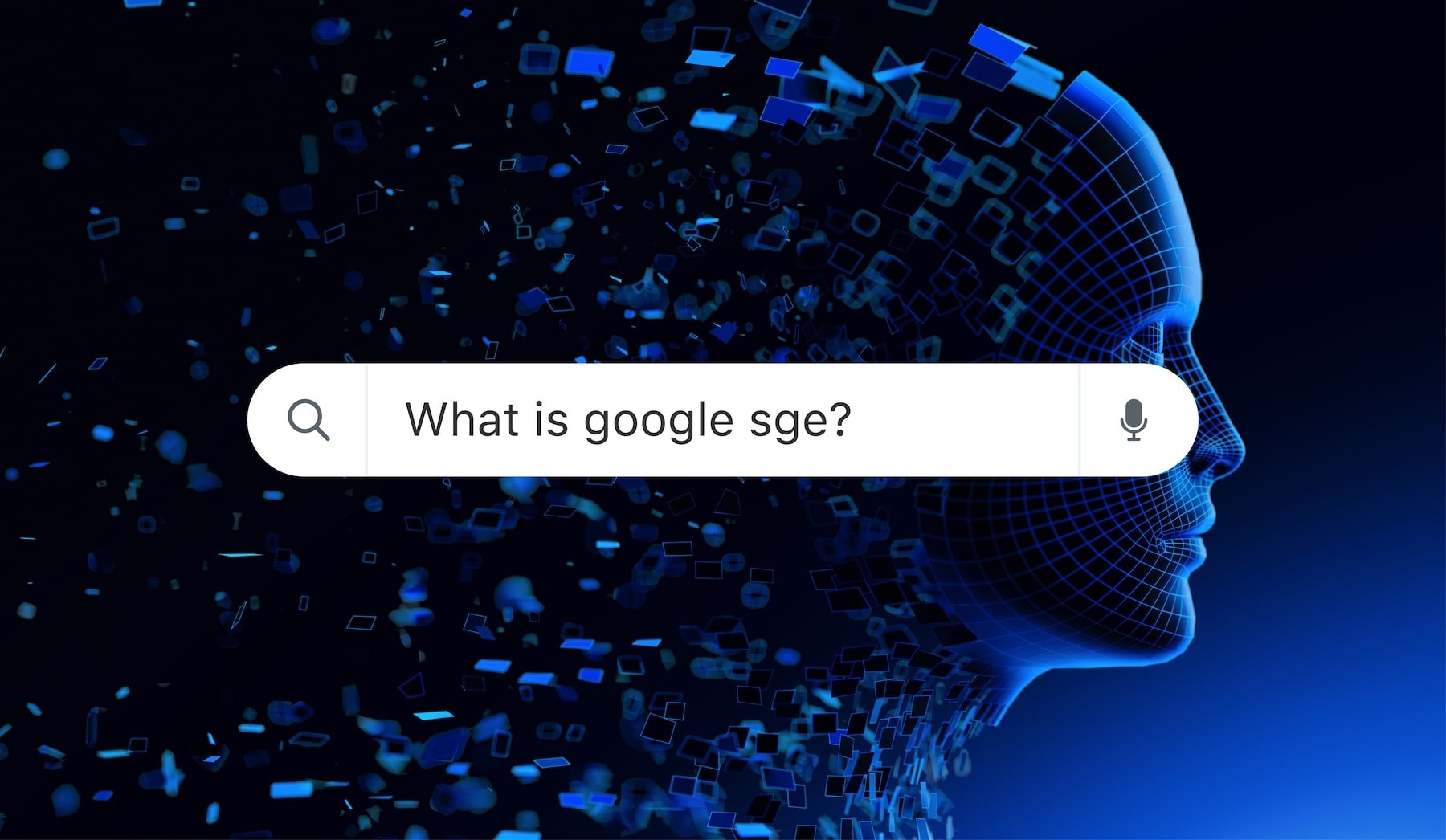

What is SGE? About Google's AI-Powered Search Expansion
B2B businesses that have thrived on traditional organic search traffic to generate leads now face rapid changes.
Google's AI-powered Search Generative Experience (SGE) is disrupting the status quo, and how you adapt your content strategy could determine success or irrelevance.
The recent global rollout of SGE signifies more than a technological upgrade. It is changing how businesses and potential customers interact.
Today, it's about seizing the future of search, not simply adapting.
What is Google Search Generative Experience (SGE)?
Google SGE uses generative AI to aggregate information from various sources and present more comprehensive search results.
Instead of displaying the same search results to all users for a query, SGE provides detailed and contextually relevant answers, improving the traditional search process.
This approach involves selecting specific information sources, but users still need to assess the quality of the information provided.
Call it cherry-picking information sources. The users must evaluate if those cherries are ripe or rotten.
SGE’s Key Features

Over the years, Google has made iterative changes to its search platform.
SGE represents more than just another minor upgrade.
It incorporates advanced generative AI and other features to deliver a more intuitive, accurate, and user-friendly search experience.
Google’s platform is not the only tool using AI to compile search results. Microsoft’s Bing incorporates artificial intelligence in its Copilot engine.
Generative AI Integration
SGE harnesses the power of generative AI to produce detailed responses beyond simple search snippets, offering users a deeper understanding of their queries. This type of artificial intelligence creates new content by analyzing and learning patterns from large datasets.
Enhanced User Experience
The conversational nature of SGE makes search interactions more natural and user-friendly, providing an experience that closely mimics human conversation.
Contextual Understanding
By maintaining context from previous interactions, SGE handles and anticipates follow-up questions, ensuring users receive accurate and relevant information throughout their search journey.
Improved Information Retrieval
SGE excels at retrieving and summarizing information from various sources, particularly useful for complex and detailed inquiries.
How SGE Improves Google Search
AI’s role in powering organic search in 2024 illustrates a revolutionary change from the launch of Google’s first public search engine in September 1998.
Efficiency
SGE anticipates follow-up questions and provides detailed responses that address the query in its entirety, unlike previous search methods that forced users to sift through multiple links and refine their queries to get the information they needed, This potentially delivers better results and saves users time with a streamlined search journey.
Accuracy
SGE is designed to improve search results accuracy. It uses AI to understand the subtleties of user queries, translating into highly relevant answers that feel personalized and precise.
However, like any advanced technology, SGE has its challenges. While it excels at delivering accurate results for straightforward queries, the complexity of some questions can sometimes lead to less-than-perfect responses.
This duality—offering groundbreaking accuracy while still grappling with the nuances of AI interpretation—reflects the ongoing evolution of SGE.
The system's ability to provide tailored and relevant information is a significant leap forward. However, AI's learning curve can occasionally impact the precision of search results.
By recognizing SGE's strengths and limitations, businesses can better understand how to optimize their content to align with this new search paradigm, and users can approach SGE with realistic expectations.
Convenience: SGE in Action
Traditional Search
To get relevant results for the ink example often required numerous keyword variations.
- Packaging inks
- Inkjet Packaging Inks
- Flexible Packaging Inks
- Solvent Inks
- TIJ Solvent Black Ink
- Thermal Inks
- Thermal Ink
- HP Black Inkjet Print Cartridge
- 45 Black HP
- HP Black 45
- HP 45 Solvent Ink
- Fast Drying Ink
- Fast Drying Ink For Plastic
- HP Fast Drying Ink
To illustrate how SGE enhances convenience, imagine a scenario where a print production manager faces a critical decision. He needs to quickly obtain a different solvent inkjet ink for printing on new packaging material.
Time was of the essence. Traditionally, a search could take hours, using multiple keywords.
The manager taps into Google's SGE-powered platform to see the best thermal solvent ink with high optical density, fast drying, and compatibility with various substrates.
The responses summarize the name of the top ink and company name, a credible academic product review, and social proof from a user.
This real-time, dialogue-driven interaction speeds up and simplifies information retrieval, allowing users to access a wealth of information in a single, streamlined experience.
By reducing the need for multiple searches and offering a more guided, conversational approach, SGE makes identifying B2B products or services easier for a potential customer if a company has anticipated the information a buyer needs to evaluate to make an informed decision.
Here’s a look at the angle of approach for digital marketers in the SGE era.
SGE's Impact on Businesses and SEO
With SGE, businesses that rely on digital marketing, especially search marketing, will likely need to adapt to maintain their online presence and visibility.
This section explores how SGE may force marketers to revisit existing SEO strategies and content optimization to maintain the competitive advantages SEO offers to forward-thinking businesses.
Keywords and Link Building Not Enough

As Google’s SGE becomes more integrated into the search ecosystem, businesses must rethink their SEO strategies to stay competitive.
Traditional tactics like keyword optimization and link building are no longer enough.
SGE’s ability to generate comprehensive, contextually rich responses shifts the focus to creating content that aligns with how AI understands and processes information.
Content Optimization
AI requires that content go beyond surface-level keywords.
It needs to be authoritative, engaging, and versatile across multiple formats.
SGE thrives on well-organized content that can be broken down into digestible segments, such as FAQs, how-tos, and step-by-step guides.
Additionally, incorporating diverse content forms like videos, infographics, and interactive elements enhances search signal optimization.
AI-driven search engines like SGE are designed to pull from various content types to build a more comprehensive and engaging response, making it crucial for businesses to diversify their content offerings.
Competitive Advantage
Adopting SGE-optimized content strategies gives businesses a substantial edge in the digital landscape. Companies prioritizing high-quality, multi-format content that leverages structured data and schema markup ensures easier AI indexing and interpretation.
This improves visibility and ranking and positions businesses as leaders in their fields, attracting more organic traffic.
Brands that quickly adapt to SGE’s nuances will gain a foothold in an increasingly AI-driven market, putting themselves ahead of competitors who continue to rely on outdated SEO practices.
SGE's Technical Prowess No Small Feat
SGE is powered by a sophisticated blend of AI and machine learning technologies designed to transform how we interact with search engines.

Beyond the user-friendly interfaces and conversational search lies a deeper, more complex structure, making it possible. One of the most critical elements is how SGE handles vast amounts of data while maintaining user privacy and security.
SGE identifies and synthesizes information from countless sources with high accuracy while adhering to stringent privacy standards.
Google has implemented robust data handling protocols to protect user information, even as SGE leverages vast datasets to deliver precise, contextually relevant answers.
Advanced encryption methods and privacy-preserving technologies are integral to SGE's framework to avoid compromising sensitive user information. Furthermore, Google's commitment to transparency in how AI models are trained and how data is used underpins users' trust in this technology.
These innovations in data handling enhance the efficiency and accuracy of SGE and set the bar for future AI-driven search.
AI involves integrating even more advanced privacy features, and refined data management systems will be crucial for maintaining users' trust and meeting increasingly complex regulatory requirements that aim to stay ahead of changes.
Challenges and Criticisms of Google SGE
Despite SGE’s vast potential to improve how users search and the results delivered, the technology comes with notable obstacles and critics.
Critical considerations are related to accuracy, data privacy, and the potential for misinformation. In this section, we address these challenges, user concerns, and industry critiques, providing a balanced perspective on SGE's current limitations and areas for improvement.
Accuracy Questioned
It’s fast, conversational, and friendly. Is it accurate? This question persists. Issues related to AI accuracy and the ability to understand complex queries remain areas for improvement.
Despite labels warning users not to use a hair dryer in a bathtub, the Google AI seemed to think other electrical appliances are safe. Based on Google SGE’s response, it seems warnings may start appearing on toasters.


Don’t do this at home!
Continued advancements in AI technology are needed to address challenges and enhance SGE's overall performance.
Privacy and Security Concerns: Addressing User Trust in AI-Driven Search

One of the most significant challenges facing AI-driven technologies like SGE is prioritizing user privacy and data security. AI systems handle increasingly complex and sensitive information and users justly have concerns about how their data is collected, stored, and used.
Google has recognized these concerns and implemented several measures to address them.
For example, Google has integrated differential privacy techniques into SGE, which allows the system to analyze data patterns without accessing or exposing individual user data. This method ensures that personal information remains anonymous and secure, even as the AI generates highly personalized responses.
Additionally, Google regularly updates its privacy policies and security protocols to comply with global data protection regulations, such as GDPR in Europe and CCPA in California, which impose strict guidelines on data handling practices.
Another example is Google's use of federated learning, an AI training technique that enables models like SGE to learn from data without storing it on centralized servers. Instead, the “learning” happens directly on users' devices, with only aggregated data and model updates sent back to Google. This decentralized approach reduces the risk of data breaches and ensures that sensitive information never leaves the user’s device.
These measures highlight Google's commitment to maintaining transparency and security in its AI-driven search technologies. By continually evolving its privacy practices and employing cutting-edge security innovations, Google aims to build and maintain trust in the face of growing concerns about data privacy. This proactive approach mitigates the risks associated with AI and sets a standard for the broader industry as AI integrates into our daily lives.
Similarly proactive is the European AI Act, effective August 1, 2024. This act establishes a framework to ensure responsible AI use in the EU, categorizing AI systems by risk levels and setting clear requirements. The Act aims to make Europe a leader in safe AI, promoting innovation and better services.
Critiques from the Industry: Balancing Innovation with Ethical Considerations

As groundbreaking as SGE is, it hasn’t escaped criticism from industry experts and competitors, particularly concerning the ethical implications of its content generation capabilities.
Of primary concern is the ongoing concern over copyright infringement and intellectual property violations. Since SGE generates content by synthesizing information from various sources, there’s a risk that the AI could inadvertently reproduce or closely mimic copyrighted material without proper attribution.
This raises significant legal and ethical questions, especially for businesses and content creators who might unknowingly publish AI-generated content that infringes on intellectual property rights.
Another critique focuses on the potential misuse of AI-generated content by users.
For instance, content generated by SGE could be used to create derivative works that violate copyright laws, or it could be published without understanding the origin of the information, leading to legal challenges. The rapid and automated nature of SGE's content creation process makes it difficult to ensure that generated material complies with existing copyright laws.
Moreover, the industry is concerned about the long-term implications of AI-generated content on original content creation. As AI models like SGE become more proficient at generating human-like content, there’s a fear that they could dilute the value of original works, making it harder for creators to protect their intellectual property and maintain control over how their content is used.
These critiques underscore the importance of establishing clear guidelines and safeguards for using AI-generated content. Google and other AI developers must continue to refine their models to avoid legal pitfalls and work closely with the legal community to ensure that AI innovations like SGE do not infringe upon intellectual property rights.
Additionally, users must be educated about the ethical and legal considerations of using AI-generated content, particularly in commercial contexts, to avoid unintentional copyright violations.
The age-old warning "caveat emptor" (buyer beware) applies to AI as well, whereas "cave usor" (user beware) must guide users in carefully evaluating the results from artificial intelligence.
By addressing these concerns head-on, the industry can balance embracing AI's innovative potential and safeguarding content creators' rights, ensuring that search technology's evolution benefits everyone involved.
Environmental Concerns: The Hidden Cost of Generative AI
While generative AI technologies like SGE offer significant advancements in search capabilities, they come with substantial environmental costs that are often overlooked.

The development and operation of AI models require vast computational power that devours considerable energy resources.
Energy consumption significantly contributes to carbon emissions, raising environmental concerns.
Training a large AI model, such as those used in generative AI, can require thousands of powerful GPUs running continuously for weeks or months. According to some estimates, training a single AI model can emit as much carbon dioxide as five cars over their lifetimes.
The electricity required to support these operations is typically sourced from fossil fuels, exacerbating the carbon footprint of AI technologies.

The ongoing operation of generative AI models like SGE, which process and generate real-time responses for millions of global users, adds to the environmental burden. Data centers housing these AI systems consume massive amounts of energy to power and cool the servers. Upgrades and scaling to keep up with demand compound the environmental impact.
As debate rages and AI continues expanding into new sectors, there’s an urgent need to address environmental implications.
Some companies are exploring ways to reduce the carbon footprint of AI by investing in renewable energy sources, improving the efficiency of AI models, and developing carbon offset programs.
However, these efforts are still in their infancy, and the industry must do more to mitigate AI's environmental impact. As businesses and consumers increasingly prioritize sustainability, the ecological impact of AI will likely become a more prominent factor in evaluating the viability and ethics of AI-driven technologies like SGE.
By acknowledging and addressing these environmental concerns, the tech industry can work towards a more sustainable future where innovation doesn’t come at the planet’s expense.
What is the Future of AI in Search?
The trajectory of AI-assisted search holds exciting possibilities for even more intelligent, context-aware, and user-centric search experiences. Here are some expert predictions and insights into Google's roadmap, highlighting the trends and innovations that will shape the future of AI in search.
Predictions and Trends
The evolution of search engines like Google’s SGE is set to bring more profound changes to how we access and interact with information. Experts foresee several key trends shaping the future of AI-driven search:
![]()
More Personalized Search Results
Future iterations of SGE will likely offer even greater levels of personalization, using AI to understand individual user preferences and contexts more deeply. This means search results will be tailored to specific queries and user’s browsing history, behavior, and emotional state, creating a highly customized search experience.
![]()
Better Contextual Understanding
AI models will become increasingly adept at understanding the context of queries, enabling them to handle more complex and nuanced questions. This will enhance search engines' ability to deliver precise and relevant answers by considering the broader context in which a query is made.
![]()
Multimodal Searching
Integrating multimodal capabilities—combining text, images, and voice inputs—will likely become more prevalent. Users will be able to interact with search engines using a variety of formats, and AI will integrate and interpret these media types to provide comprehensive answers.
![]()
Real-Time Responsive Results
AI-driven search systems will continue to evolve in their ability to adapt in real-time. As the technology learns from ongoing interactions and feedback, these systems will improve accuracy and relevance, offering users more dynamic and responsive search experiences.
![]()
Importance of Ethics and Transparency
There will be a growing emphasis on ensuring that AI technologies, including SGE, are developed and deployed with ethical considerations. This includes addressing privacy concerns, mitigating biases, and ensuring transparency in how AI models make decisions and generate content.
Overall, the future of AI in search promises to bring more intelligent, intuitive, and user-centric experiences. Businesses and users should prepare for these advancements by staying informed about emerging trends and adapting their strategies to leverage the evolving capabilities of AI-driven search technologies.
Google’s Roadmap: What’s on the Horizon for SGE
Google’s roadmap for SGE outlines ambitious plans for the future, focusing on technological advancements and enhanced user experiences.
Advanced AI Capabilities
Google aims to continually refine SGE's AI algorithms to improve its understanding of complex queries and deliver even more accurate and contextually relevant answers. This involves ongoing research into natural language processing and machine learning to enhance the system’s ability to handle nuanced user interactions.
Integration with Emerging Technologies
Future updates are expected to integrate SGE with other emerging technologies, such as augmented reality (AR) and virtual reality (VR). This integration will enable new interactive and immersive search experiences, allowing users to engage with information in more dynamic and engaging ways.
Enhanced Personalization
Google plans to deepen SGE’s personalization capabilities, using advanced AI to tailor search results based on individual user behavior, preferences, and context. This will create a more customized search experience, improving relevance and user satisfaction.
Improved Privacy Measures
As data privacy concerns grow, Google is committed to enhancing its privacy protocols. Future developments will include more robust data protection measures and transparency features, ensuring user information is handled securely and ethically.
Expansion of Global Reach
Google intends to expand SGE’s availability to more regions and languages, making its advanced search capabilities accessible to a broader global audience. This will involve adapting SGE’s AI to different cultural and linguistic contexts to provide accurate and relevant results worldwide.
By staying informed about these developments, businesses can better prepare for the evolving landscape of search technology and leverage SGE’s advancements to maintain a competitive edge.
As Google pushes the boundaries of AI-driven search, being proactive and adaptable will be key to capitalizing on the opportunities presented by these innovations.
Leveraging Google's AI-Powered Search for Marketing Success
For businesses, adapting to this shift in search behaviors prompted by the integration of AI and SGE is crucial.
SEO strategies will require pivoting towards high-quality, in-depth content that aligns with Google SGE’s generative capabilities and tendencies. Embracing content optimization and leveraging SGE’s features can offer a significant competitive edge for driving visibility and establishing thought leadership in your industry.
Here at DBS, our commitment to understanding these advancements and guiding our clients through the complexities of AI-driven search marketing positions us at the forefront of the industry.
For almost as long as Google search has been around, DBS Interactive has been helping clients rise to the top of search rankings with organic and technical SEO. By aligning strategies with advancements in AI-driven search, we continue assisting businesses in maintaining or securing their market position in online search results for a competitive advantage.
Curious how we can help make your brand more visible in Google's AI generated search results?
FAQs
Google Search Generative Experience or SGE, is Google’s AI-powered search that uses generative AI to provide detailed, context-specific answers to questions. Instead of listing links, it combines information from multiple sources to create more helpful, conversational responses.
Unlike traditional search, the user scrolls through a list of links to locate the answer to their query. SGE delivers a single comprehensive answer to the query, and it anticipates follow-up questions, making the process faster and easier.
SGE saves time by offering direct answers, which reduces the need for multiple searches and delivers a conversational experience. It also provides detailed information tailored to the user’s specific query.
Businesses should focus on creating clear, well-structured content that’s easy for AI to process. For example, Frequently Asked Questions (FAQs), guides, and schema markup while incorporating diverse formats like videos and infographics.
Traditional SEO tactics like keyword optimization aren’t enough for SGE. Websites must have high-quality, in-depth content that aligns with how AI understands and organizes information.




